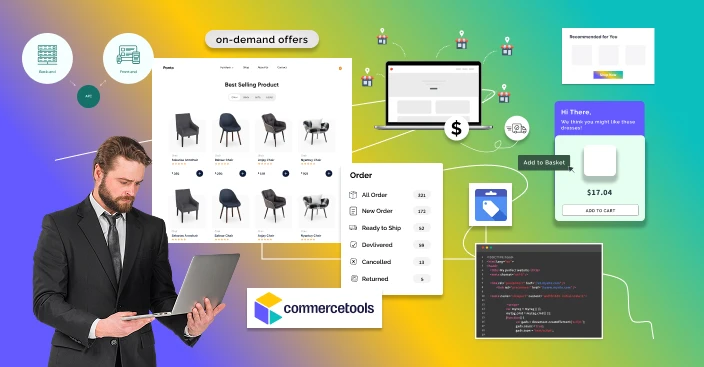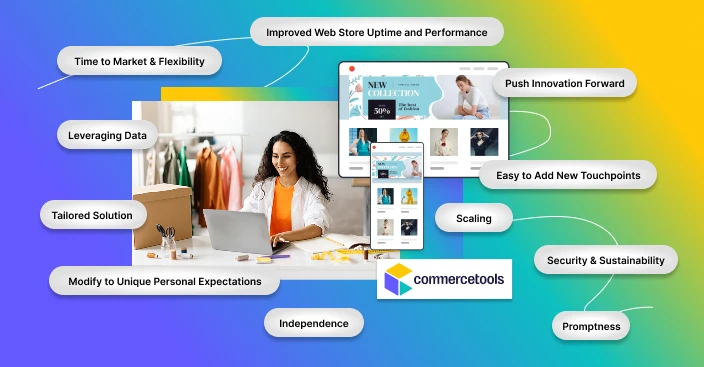11 Reasons Why eCommerce Businesses Are Shifting Towards New Platforms

When desktop-based eCommerce first emerged in the 1990s, the first generation of digital commerce offered massive, all-inclusive suites as its standard. There were two options for shopping: in-store purchases and online purchases.
How times have changed! Customers today expect omnichannel shopping, lightning-fast website speed, Google-like search capabilities, and significant brand experiences.
Never before have businesses been more multinational, multi-brand, and complicated. In a word, the slow-moving, steady age of desktop-only eCommerce is over.
As of 2025, 70% of e‑commerce brands are either implementing or evaluating headless commerce to enhance speed and personalization, and the global headless market is projected to reach $25 billion by 2025 (up from ~$1.7 billion in 2023)
Companies must act more quickly than ever to meet customer expectations, expand into international markets, and introduce new products. The key to their development and success is innovation.
But if innovation is necessary for a business’s growth, why is it so challenging to implement? Why do companies use fixed-release cycles when they can continuously offer new ideas?
The answer is simple: monolithic systems designed for desktop-only eCommerce are insufficient for companies.
Why Are Monolithic Platforms Not Compatible Anymore?
Monolithic eCommerce systems offer a universally applicable solution. However, it is a hard, indivisible chunk of standardized software that needs to be retested and redeployed each time a modification or update is scheduled.
Imagine incorporating modern touchpoints into your shopping experiences, like social commerce applications. You can ultimately deliver omnichannel commerce; In your firm, everyone is ecstatic, and C-Level management has approved your proposal. First, however, integrating it into your rigid commerce system is a challenge.
In other words, months in advance, your IT and DevOps teams need to prepare for the integration of the new feature. This meticulously planned roadmap exists because whenever a change is made to the monolithic platform, the whole program and its closely tied dependencies must be updated simultaneously, even when adding a little feature like a social commerce app.
Integrating the new function might severely damage your IT system if something goes wrong. Consider service interruptions, platform outages, weak points that are vulnerable to malicious attacks, or, in the worst-case scenario, a total system crash.
Given how difficult it is to accomplish anything on monolithic platforms, it is understandable why technical teams are averse to change and feel the need to have complete control over their roadmaps. Therefore, the cycle of innovation resistance never ends: you encounter resistance while attempting to expand the functionality of online stores.
This low-risk strategy ultimately leads to technical debt and subpar company performance, with all attempts at innovation ultimately failing.
Time to Move to a New Wave: Commercetools
As we have seen, we are undergoing a major shift from monolithic, but what is the solution?
Let’s use the example of implementing a social commerce app once again. Think of it as a single piece of software that can be plugged into your infrastructure without any dependencies and has no impact on the rest of your application.
This is what a microservice-based strategy does: it breaks down functionality into granular bits, making them more agile and dependable while offering faster answers and allowing them to be delivered more often.
This proves that the shift from monolithic legacy eCommerce platforms to microservice-based headless solutions is of a significant move. While COVID‑19 catalyzed the shift, the surge in AI, personalization, and omnichannel in 2025 continues to reinforce the need for flexible commerce stacks. 87% of adopters report better personalization, and 82% say that headless improves the integration of new technology.
This massive shift is the outcome of eCommerce’s impact on the technical landscape and eCommerce tendencies.
Very few platforms take a headless approach, but we can observe that Headless and API-driven eCommerce is one of the recent trends in eCommerce that stands out. It promotes continuous innovation.
What does “headless” actually mean? A headless commerce platform manages all backend operations, business logic, and data. A headless CMS makes content available through an API for display on any device that lacks a front-end or presentation layer. The idea of cutting the “head” (the front end) off the “body” is where the name “headless” originates (the backend).
So, the question is how all of this data is made available through adaptable commercetools.
Commercetools makes it possible to link various frontend (heads) forms, including common webshops, applications, voice assistants, and smart gadgets. Because of the enhanced SEO, content marketing, and digital experience capabilities, more eCommerce organizations are implementing commercetools.
What is Commercetools?
Commercetools is the world’s top product portfolio for next-generation B2C, D2C, and B2B commerce. Commercetools created a headless, API-first, multi-tenant SaaS commerce platform that is cloud-native and uses adaptable microservices to free the market from the constraints of traditional suites.
Businesses can provide the best commerce experiences across every touchpoint on a wide scale by using current development building blocks in a genuine cloud platform supplied by commercetools.
The MACH Architecture: 2025 Pillars of Next-Gen eCommerce
Commercetools is built on the MACH architecture, Microservices, API-first, Cloud-native, and Headless, a forward-thinking model first formalized in 2018.
As of 2025, this architecture has become the global benchmark for enterprise commerce, with over 73% of businesses implementing MACH or planning to within the next year, according to the MACH Alliance.
This framework empowers brands to stay agile, scalable, and innovation-ready in today’s composable commerce era.
The following four pillars of the next-generation commerce platform are known as the” Big Four”:
- Microservices refer to independently deployable components that communicate via APIs. Each service handles a specific business function—such as checkout, promotions, or cart—and can be developed, tested, and deployed independently.
In 2025, nearly 64% of eCommerce companies using MACH have experienced a 2x faster deployment speed, thanks to microservices. This agility lets teams roll out updates or new features without disrupting the rest of the system.
- API-first means that every function within Commercetools is accessible through a clean, scalable API. This enables seamless integration with CRMs, ERPs, PIMs, CMSs, and custom frontends.
As per 2025 reports, 80% of MACH adopters state that API-first systems significantly reduce integration costs and vendor lock-in. This makes Commercetools an ideal platform for businesses looking to innovate quickly across touchpoints.
- Unlike cloud-hosted apps, Commercetools is cloud-native—built from the ground up for distributed scalability and reliability. Everything—development, testing, deployment—happens in the cloud. With cloud-native infrastructure, businesses can scale globally without downtime, and updates are continuous.
In fact, 89% of MACH users in 2025 cited improved uptime and cost savings of up to 30% by eliminating infrastructure overhead.

Headless commerce decouples the front end from the backend, allowing brands to deliver custom digital experiences across channels—web, mobile, voice, AR/VR, and more.
By 2025, over 70% of enterprise brands have adopted headless strategies, citing faster content delivery, improved UX, and better SEO performance. Commercetools enables this by serving data via API to any frontend, giving brands total creative freedom and omnichannel consistency.
These MACH principles aren’t just theory; they’re being validated: 73% of merchants say headless is critical to future success, 61% see faster performance, and 65% think headless is essential for omnichannel delivery.
Who Can Use Commercetools?
Commercetools is a sophisticated commerce system that can handle any form of transaction.Commercetools is used by leading global brands—and in APAC, the fastest-growing
MACH region, India leads the way. The Indian e-comm market hit $147 billion in 2024 and is growing ~19% annually through 2028, with ~400 million digital shoppers expected by 2027. It can manage every step of the ordering and booking procedures.
This toolkit is open. It functions equally well with a content management system (CMS) as it does with a framework or other application that has a front end and allows user interaction.
Commercetools also provides personalized commercial experiences through the use of interconnected microservices.
Scaling is a distinct additional feature that commercetools provides. No matter how many or complicated articles a business has, or how much site traffic or orders there are, it has no size or technological restrictions due to commercetools’ platform independence and cloud infrastructure.
Why eCommerce Businesses Are Moving to Commercetools: 11 Solid Reasons
With headless commerce, the frontend and backend layers of the apps are separate and are only connected through an API. From a technology standpoint, headless commerce makes perfect sense in rapidly evolving user behavior.
However, a distinct head on the same backend is necessary if the clients utilize various frontends or devices. Let us delve deeper into why commercetools are crucial for businesses today and the reason for their shift.
1. Time to Market & Flexibility
One of the most crucial factors for organizations that are changing quickly is time to market as part of eCommerce growth in 2025. Everybody wants to outperform their rivals by two steps while providing the greatest customer service imaginable.
One of the key aspects of developing an industry-sized e-commerce application that will keep you competitive is the time to market.
With the aid of Commercetools, a brand-new e-commerce application may be developed in only two weeks. You ask how. We’re about to get technical, but a typical development cycle for business systems comprises creating the database structure, developing APIs, stress testing, unit testing, managing servers, conceptualizing the architecture, and various other backend-related chores.
Why not reuse it when most e-commerce utilizes the same database structure and technology, and all of these things are already taken care of by commercetools?
Reusing components saves time, and being able to design the front end separately from the back end allows company owners the freedom to decide what occurs there and the opportunity to create a unique identity for their brand. With this flexibility, business owners may take advantage of business possibilities and benefit from effective eCommerce software maintenance, reducing market time.
2. Leveraging Data
When you require more than simply a shopping cart, working with commercetools is one of the main reasons to do so. While many eCommerce providers are simply interested in boosting revenue, commercetools offers a customizable solution that enables you to add value and understand your clients better.
This makes the process easier for customers and allows your company to collect valuable information on who its customers are and how they use its products.
3. Tailored Solution
Choosing commercetools represents a big change toward modular solutions that lets you choose the most useful components to meet your needs. In addition, integrating technology and data with business strategy helps establish local digital transformation teams. This makes it possible to design and expand platforms that simply and swiftly reach our customers by truly understanding the exact features they want.
4. Modify to Unique Personal Expectations
Using a headless solution, commercetools frees the user from dependence on a large-scale program that dictates how a front end should be structured. There is no set template system, and personnel can be educated to follow the software vendor’s particular standards.
The front end is completely under the user’s control, and the brand identity may be developed without a pre-made layout. Furthermore, it prevents your website or app from looking exactly like anybody else’s since one can use their UX design concepts.
5. Independence
Suppose a test is required for a particular area of a commerce website. In that case, commercetools allow for the creation of errors without disrupting backend operations, unlike conventional commerce solutions, which require simultaneous changes to both the front and back end of the code.
It was occasionally necessary to shut down the entire application for maintenance. But with commercetools, experiments with user involvement can be conducted without endangering the entire ecosystem. With the opportunity to experiment, development expenses may also be reduced.
6. Scaling
Usually, with commercetools, it is possible to scale the front and back end separately. Even if the front has high traffic, the back end won’t be impacted because they are only loosely linked. Along with stabilizing availability, this lowers operating costs.
7. Promptness
Since the development teams may collaborate simultaneously, the development process becomes significantly more effective. It is not essential to install and maintain full-stack software. Thus the freedom to experiment enables the quick construction of unique user interfaces.
Due to its dissociated structure, altering the UI does not require modifying the backend’s fundamental functionality.

The average speed of your website with commercetools can also be increased to 70%. And eventually, your company may gain a lot from improved development efficiency and a shorter time to market.
8. Easy to Add New Touchpoints
In the case of headless commerce, no software upkeep is required if new touchpoints are to be introduced. It is so that several frontends may access one underlying system and one API.
9. Improved Web Store Uptime and Performance
Had several scalability problems with SAP’s frequent flyer e-shop over the years, which cost you money and upset customers?
Replatforming the frequent flyer rewards website from SAP to commercetools will increase availability and performance using a cloud-native design, extending cloud capacity to handle traffic spikes.
10. Push Innovation Forward
It’s so difficult to modify or upgrade using a monolithic platform like SAP that businesses often fall into siloed thinking and technological debt. Using MACH to transform eCommerce transforms the corporate attitude toward high-velocity, output-driven teams.
As you transition to commercetools, eCommerce and marketing teams may stretch their ideas about what’s possible, resulting in continuous product delivery and a fast-moving innovation roadmap.
11. Security & Sustainability
Imagine never having to worry about updates, maintenance, or high availability. Sounds great, right? It is feasible with commercetools since it is a fully-managed cloud platform with the highest security standards.
Also, a carefully thought-out and sophisticated commerce architecture provides the framework for long-term platform operation and continuous company growth development.
What Does Commercetools Do?
Commercetools’ API-first model enables seamless integration with AI‑driven tools for dynamic pricing, personalized promotions, and ML-based recommendations, all decoupled from the backend.
1. Create Headless Platform API
As previously said, commercetools is a headless e-commerce platform allowing easy development in any language and framework. With Commercetools, you can create custom e-commerce applications quickly and using whatever tool you choose, with the quickest time to market of any business commerce platform.
Commercetools also allows customers to completely customize the front end without being constrained by the guidelines established by the software vendor. Furthermore, without compromising the reliability of the backend, they can swiftly experiment and A/B test new features. By separating frontend and backend functionalities, commercetools improve client experience while reducing costs.
2. Easy Catalog Management
Using commercetools, you can manage products, product kinds, and variants. As well as this, you will be able to manage intricate customizations in dedicated views to make your business more understandable to consumers.
3. Get a Unified Cart
The commercetools unified cart makes it simple to handle anything from pricing to delivery, currencies to discounts. Additionally, it will enable you to create multiple stores with the same shopping behavior.
4. Order management
To build a completely integrated commerce experience, users must be involved at each point of the user journey. They must also be notified about product availability by channel and retail location. Commercetools make it possible for your consumers to transact with you both offline and online without running into any restrictions.
You may also check the progress of your order with just one finger tap. For example, Click-and-Collect orders for a specific physical store may be retrieved directly from the screen.
5. Machine learning
Machine learning (ML) technology, which utilizes your data, enables the capacity to analyze trends without direct instructions. The commercetools platform uses this to provide product suggestions, personalized promotions, and on-demand offers. In addition, it may be used in the technology stack to simplify and accelerate installations.
6. Merchant center
With the help of Commercetools, users may manage any administrative tasks they encounter when running an online business. It also comes with a sophisticated Product Information Management (PM) that is natively integrated without needing installation or integration. In addition, users may fully edit, alter, and take full control of the product catalog thanks to the integrated merchant center and PM.
7. Developer tooling
The commercetools platform is versatile and expandable, allowing you to build any scenario you can think of. This adaptability entails using patented technologies to modify data models, business processes, and APIs tailored specifically for commerce.

Conclusion
eCommerce business are shifting towards in a new platform, this is comes with some innovative technologies. With the implementation of commeretool, MACH tech support and more helps to grow the eCommerce business with excellence.
There are various reasons to boost the eCommerce growth, all of them are designed to take the brand to a new state.
Connect with eCommerce experts for understand the key reasons of choosing new platform for boosting the business growth.
FAQs
 Why are eCommerce businesses moving away from old platforms?
Why are eCommerce businesses moving away from old platforms?
Old monolithic platforms are slow, rigid, and hard to update. Modern businesses need speed, flexibility, and the ability to innovate quickly, something old systems can’t deliver.
 What is headless commerce?
What is headless commerce?
Headless commerce separates the backend (where data and business logic live) from the frontend (what customers see). This allows brands to create unique shopping experiences on any device without changing the backend.
 What makes Commercetools different from traditional platforms?
What makes Commercetools different from traditional platforms?
Commercetools is built on MACH architecture—Microservices, API-first, Cloud-native, and Headless. This means faster updates, easy integrations, better scalability, and complete creative freedom for your storefront.
 Can Commercetools help with faster time-to-market?
Can Commercetools help with faster time-to-market?
Yes. Its modular, pre-built components and API-first approach allow businesses to launch features, apps, or new storefronts in weeks instead of months.



